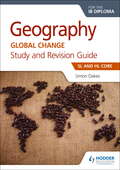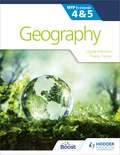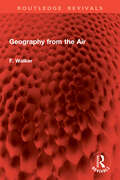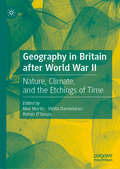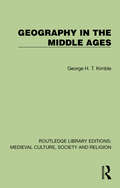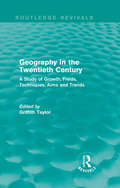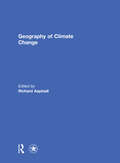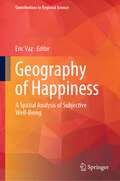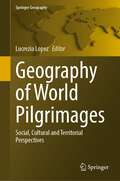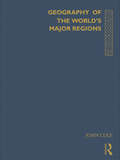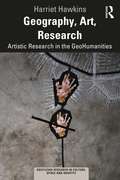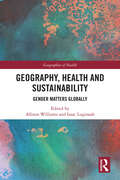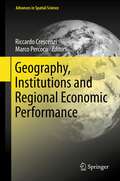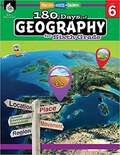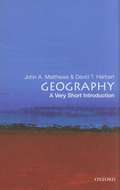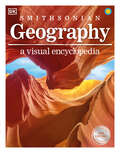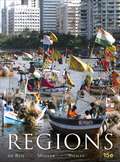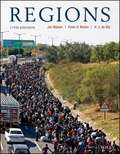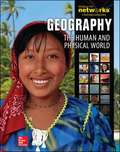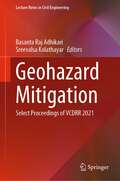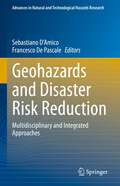- Table View
- List View
Geography for the IB Diploma Study and Revision Guide SL and HL Core: SL and HL Core
by Simon OakesStretch your students to achieve their best grade with these year round course companions; provides comprehensive content on all topics, and practice questions to support and strengthen learning. - Develop understanding and knowledge with clear and concise coverage of the syllabus- Target learning with individual books for Standard and Higher level- Consolidate revision and check understanding with a range of exam practice questions- Practise exam technique with tips from examiners throughout on how to tackle questions- Focus revision with key terms and definitions listed for each topic/sub topicAnswers are free online at www.hoddereducation.com/ibextras
Geography for the IB Diploma Study and Revision Guide SL and HL Core: SL and HL Core
by Simon OakesExam Board: IBLevel: IBSubject: GeographyFirst Teaching: September 2017First Exam: Summer 2019Stretch your students to achieve their best grade with these year round course companions; provides comprehensive content on all topics, and practice questions to support and strengthen learning. - Develop understanding and knowledge with clear and concise coverage of the syllabus- Target learning with individual books for Standard and Higher level- Consolidate revision and check understanding with a range of exam practice questions- Practise exam technique with tips from examiners throughout on how to tackle questions- Focus revision with key terms and definitions listed for each topic/sub topic
Geography for the IB MYP 4&5: by Concept
by Louise Harrison Thierry TorresDevelop your skills to become an inquiring learner; ensure you navigate the MYP framework with confidence using a concept-driven and assessment-focused approach to Geography, presented in global contexts.- Develop conceptual understanding with key MYP concepts and related concepts at the heart of each chapter. - Learn by asking questions for a statement of inquiry in each chapter. - Prepare for every aspect of assessment using support and tasks designed by experienced educators.- Understand how to extend your learning through research projects and interdisciplinary opportunities.- Think internationally with chapters and concepts set in global contexts.
Geography for the IB MYP 4&5: by Concept
by Louise Harrison Thierry TorresDevelop your skills to become an inquiring learner; ensure you navigate the MYP framework with confidence using a concept-driven and assessment-focused approach to Geography, presented in global contexts.- Develop conceptual understanding with key MYP concepts and related concepts at the heart of each chapter. - Learn by asking questions for a statement of inquiry in each chapter. - Prepare for every aspect of assessment using support and tasks designed by experienced educators.- Understand how to extend your learning through research projects and interdisciplinary opportunities.- Think internationally with chapters and concepts set in global contexts.
Geography from the Air (Routledge Revivals)
by F. WalkerFirst Published in 1953, Geography from the Air is the first book in English to explain and illustrate fully the use of air photographs in the study of geography. It sets out in simple form the limited amount of technical information which is necessary in order to enjoy fully the fascinating experience of training oneself to appreciate almost every aspect of the landscape shown on vertical air photographs. Thereafter the book consists of nearly 100 high quality air photographs, selected from almost every part of Britain, each of which is accompanied by a text describing in detail the features of general, as well as of geographical, interest which can be detected on the photographic prints.The photographs have been grouped into sections detailing with many aspects of physical and human geography, such as the influence of geology on landforms, river erosion and river development, glacial action, coast forms, the relationships between relief and settlement, the appearance of varying agricultural and industrial regions and the shape and character of towns and villages etc. Apart from the explanation of this new geographical technique the selection of photographs is such that this book should serve as a valuable source of illustrative material for the study of the geography of Britain and the systematic treatment of physical and human geography.
Geography in Britain after World War II: Nature, Climate, and the Etchings of Time
by Vinita Damodaran Max Martin Rohan D’SouzaContemporary anxieties about climate change have fueled a growing interest in how landscapes are formed and transformed across spans of time, from decades to millennia. While the discipline of geography has had much to say about how such environmental transformations occur, few studies have focused on the lives of geographers themselves, their ideologies, and how they understand their field. This edited collection illuminates the social and biographical contexts of geographers in postwar Britain who were influenced by and studied under the pioneering geomorphologist, A. T. Grove. These contributors uncover the relationships and networks that shaped their research on diverse terrains from Africa to the Mediterranean, highlighting their shared concerns which have profound implications not only for the study of geography and geomorphology, but also for questions of environmental history, ecological conservation, and human security.
Geography in Classical Antiquity
by Daniela Dueck a chapter by Kai BrodersenWhat were the limits of knowledge of the physical world in Greek and Roman antiquity? How far did travellers get and what did they know about far-away regions? How did they describe foreign countries and peoples? How did they measure the earth, and distances and heights on it? Ideas about the physical and cultural world are a key aspect of ancient history, but until now there has been no up-to-date modern overview of the subject. This book explores the beginnings and development of geographical ideas in Classical antiquity and demonstrates technical methods for describing landscape, topographies and ethnographies. The survey relies on a variety of sources: philosophical and scientific texts but also poems and travelogues; papyrological remains and visual monuments.
Geography in the Middle Ages (Routledge Library Editions: Medieval Culture, Society, & Religion)
by George H. KimbleOriginally published in 1938, this book was the first to cover the history of geographical thought. It discusses the development of medieval earth-knowledge as it was affected, on the one hand, by the prevailing Christian and Muslim ideologies and, on the other, by the results of human enterprise on land and sea.
Geography in the Twentieth Century: A Study of Growth, Fields, Techniques, Aims and Trends (Routledge Revivals)
by Griffith TaylorThis title, first published in 1951, examines the growth, fields, techniques, aims and trends of geography at the time. The book is divided into three parts, of which the first deals with the evolution of geography and its philosophical basis. The second is concerned with studies of special environments and with advances in geomorphology, meteorology, climate, soils and regionalism. The last part describes field work, sociological and urban aspects, the function of the Geographical Society and geo-pacifics. Geography in the Twentieth Century will be of interest to students of both physical and human geography.
Geography of Climate Change
by Richard AspinallClimate change is one of the inescapable themes of current times. Climate change confronts society in issues as diverse as domestic and international political debate and negotiation, discussion in the media and public opinion, land management choices and decisions, and concerns about environmental, social and economic priorities now and for the future. Climate change also spans spatial, temporal and organisational scales, and has strong links with nature-society relationships, environmental dynamics, and vulnerability. Understanding the full range of possible consequences of climate change is essential for informed decision making and debate. This book provides a collection of chapters that span environmental, social and economic aspects of climate change. Together the chapters provide a diverse and contrasting series that highlights the need to analyze, review and debate climate change and its possible impacts and consequences from multiple perspectives. The book also is intended to promote discussion and debate of a more integrated, inclusive and open approach to climate change and demonstrates the value of geography in addressing climate change issues.This book was originally published as a special issue of Annals of the Association of American Geographers.
Geography of Happiness: A Spatial Analysis of Subjective Well-Being (Contributions to Regional Science)
by Eric VazThis book offers readers a spatial understanding of happiness and subjective well-being. By integrating spatial and geostatistical methods, it sheds new light on the spatial and geographical aspects of subjective well-being. Geographical analysis allows us to measure spatial and regional discrepancies in subjective well-being and to identify heterogeneous profiles in terms of social, economic and environmental patterns. Consequently, the papers gathered here address various topics concerning the spatial aspects of subjective well-being, including social injustice, age, new urban spaces, and tourism. The book proposes a multidisciplinary approach and is intended for scholars and students in the fields of geography, economics and the spatial sciences. By examining several critical dimensions of happiness and subjective well-being, it enriches the complexity of regional decision-making on the path toward happier and more liveable societies.
Geography of World Pilgrimages: Social, Cultural and Territorial Perspectives (Springer Geography)
by Lucrezia LopezThis book points out how pilgrimage studies rely on interdisciplinary academic interests, being always more determined by anthropological, social, cultural and economic factors. The volume gathers interdisciplinary contributions revealing different approaches and academic interests when researching pilgrimage. Finally, the proposal introduces a comparative international breath to reflect upon such complex phenomenon that since Antiquity still impregnates the history of human being across the world. As pilgrimage studies are closely related to mobility issues, how the contemporary mobile world is altering and re-signifying pilgrimage dynamics and meanings will also be discussed in detail. The term “pilgrimage” evokes key concepts deriving from different fields, all of them collected in the final glossary.The primary audience of this work are academics and researchers from different fields involved in pilgrimage studies. The work may also be useful in teaching (advanced) university courses.
Geography of the World's Major Regions
by John ColeThis volume presents a global view of today's most pressing issues through an analysis of the twelve major regions of the world. Environmental degradation, natural catastrophe, population pressures and human conflict all impact in different ways and to different degrees on the society and environment of these regions. Economic and political restructuring within each region is covered, and topics include: natural resources; agriculture; industry and services; the role of the military; and the impact of global economic change. This work is intended as an introduction for students studying the changing geography of the world, but should also provide a useful overview to students researching specific regions, seeking comparative analysis of regions, or following general courses on the economic and political geography of both the post-industrial and the developing worlds. Over 250 photographs, maps and figures complement a range of boxed case-studies, key points, questions and guides to further reading.
Geography, Art, Research: Artistic Research in the GeoHumanities (Routledge Research in Culture, Space and Identity)
by Harriet HawkinsThis book explores the intersection of geographical knowledge and artistic research in terms of both creative methods and practice-based research. In doing so it brings together geography’s ‘creative turn’ with the art world’s ‘research turn.’ Based on a decade and a half of ethnographic stories of working at the intersection of creative arts practices and geographical research, this book offers a much-needed critical account of these forms of knowledge production. Adopting a geohumanities approach to investigating how these forms of knowledge are produced, consumed, and circulated, it queries what imaginaries and practices of the key sites of knowledge making (including the field, the artist’s studio, the PhD thesis, and the exhibition) emerge and how these might challenge existing understandings of these locations. Inspired by the geographies of science and knowledge, art history and theory, and accounts of working within and beyond disciplines, this book seeks to understand the geographies of research at the intersection of geography and creative arts practices, how these geographies challenge existing understandings of these disciplines and practices, and what they might contribute to our wider discussions of working beyond disciplines, including through artistic research. This book offers a timely contribution to the emerging fields of artistic research and geohumanities, and will appeal to undergraduate and postgraduate students and researchers.
Geography, Health and Sustainability: Gender Matters Globally (Geographies of Health Series)
by Allison Williams Isaac LuginaahWith a global commitment to achieve gender equality by 2030, the SDGs present a historic opportunity to place gender as central to human progress across the globe. Gender equality, which requires the empowerment of all women and girls, is an explicit goal, in addition to being a fundamental prerequisite to and facilitator of most other SDGs. This edited collection provides a range of geographical and geospatial insights, from a variety of disciplinary and country-specific perspectives, to better understand gender and sustainable development. In addition to several African countries, Mexico, Japan, Canada, USA, and Cambodia are featured. A range of topical case studies examine women’s domestic and care work, including water collection, breastfeeding, food purchasing, and caring for elderly family members. Access to health care services is examined in the case of breast screening and antenatal care. Women’s engagement in the labour force is also addressed, with a specific look at the renewable energy sector; structural barriers to employment are discussed across a number of chapters, with clear strategies to break through these barriers. Finally, theoretical insights are proposed in better understanding and engaging in gendered inequalities in health.
Geography, Institutions and Regional Economic Performance
by Marco Percoco Riccardo CrescenziThe book aims to present "traditional features" of regional science (as geographical concepts and institutions), as well as relatively new topics such as innovation and agglomeration economies. In particular it demonstrates that, contrary to what has been argued by recent economics literature, both geography and institutions (or culture) are relevant for local development. In fact, these phenomena, along with the movement of goods and workers, are among the main reasons for persisting development differentials. These intriguing relationships are at the heart of the analysis presented in this book and form the conceptual basis for a promising institutional approach to economic geography.
Geography, Level 6: Practice, Assess, Diagnose
by Jennifer EdgertonSupplement your social studies curriculum with 180 days of daily geography practice! This essential classroom resource provides teachers with weekly geography units that build students' geography knowledge, and are easy to incorporate into the classroom. <p><p> In a world that is becoming more connected and globalized, 21st century students must have the skills necessary to understand their world and how geography affects them and others. Students will develop their map and spatial skills, learn how to answer text- and photo-dependent questions, and study the 5 themes of geography. Each week covers a particular topic and introduces students to a new place or type of map. <p><p> The first two weeks consist of a mini-unit that focuses entirely on map skills. For additional units, students will study various places, and how culture and geography are related. With a focus on the six populated continents, students will explore various types of maps including physical maps, political maps, topographic maps, thematic maps, climate maps, regional maps, and various topics including scale, legends, cardinal directions, latitude and longitude, and more. Aligned to state standards and National Geography Standards, this resource includes digital materials.
Geography: A Very Short Introduction
by John A. Matthews David T. HerbertThis Very Short Introduction answers four basic questions: what is geography, how do geographers work, why is geography important, and where is the discipline of geography heading? Geography has always been important, though it has had only a short history as an academic discipline and is much misunderstood. Modern Geography has come a long way from its historical roots in exploring foreign lands, in mapping the world and in describing the physical and human features of the Earth's surface. There are two parts to the discipline: Physical Geography, which covers natural environments and landscapes; and Human Geography, which investigates people and the cultural landscape. Physical and human geographers commonly do not agree with each other. But there are also common elements and geography as a whole has an important role as a bridge between the sciences and the humanities. Using wide-ranging examples, the book paints a broad picture of the current state of geography, its subject matter, concepts and methods, how it developed, and its strengths and weaknesses. The book's conclusion is no less than a manifesto for geography's future.
Geography: A Visual Encyclopedia
by DKLearn all about geography on planet Earth in this jam-packed visual encyclopedia for children.Get to know the processes that shape our world through amazing facts and colorful diagrams in this fully updated edition of the popular Geography A Children’s Encyclopedia.This encyclopedia for children aged 9-12 is full of beautiful pictures that bring the natural world to life and show Earth’s most amazing features. Each concept is broken down clearly, with colorful diagrams describing geological processes, while the water cycle and the structure of a rainforest canopy are fully explained.This geography book for kids offers:All aspects of physical and human geography explained clearly with the help of maps and country factfiles.A refreshed and updated edition, including a new design and the latest facts and stats on the subject.An essential reference for children, looking at the latest topics like the effects of climate change.Learn about the processes that shape our world, from ice ages to global warming, earthquakes to tsunamis, and explore the wonders of the natural world, from the peak of Mount Everest to the very bottom of the Mariana Trench.Children can carry the world wherever they go, from the deserts of Africa to the low countries of Europe, the lush forests of Brazil to the coral reefs of Indonesia and Australia. This encyclopedia expands horizons and is a fantastic resource for children interested in geography, geology, environmental science, and sociology.Explore the series!Globally, the Children’s Encyclopedia series has sold more than 4 million copies worldwide. Uncover the marvels of our world with Science, explore the deep blue with Ocean, discover our solar system and beyond with Space, understand anatomy with Human Body, and get to grips with world-famous sculptures with Art.
Geography: Realms, Regions and Concepts
by Peter O. Muller H. J. de Blij NijmanThe 15th Edition of H. J. deBlij and Peter Mullers "Geography: Realms, Regions, and Concepts" has been expanded and enhanced upon previous editions. This carefully crafted text by one of the most traveled, knowledgeable and authoritative geography authors, H. J. deBlij provides a comprehensive understanding about the world with a long history of on authoritative content, outstanding cartography, currency, and comprehensive coverage, in a technology-rich package. A new online World Regional Geography program is one of many new strong and effective technologies included. New Organization Chapters are now divided into A/B sections. Within each chapter, Part A, Defining the Realm, examines developments that unfold across the entire realm or major parts of it. In Part B, Regions of the Realm, the authors explore the regions within the realms to view developments at a finer resolution and examine the role of individual states and national cultures. New and updated content incorporated into the narrative of every chapter. Chapters 8A and 8B (South Asia), for example, now discusses recent developments in the cultural and religious conflict between Pakistan and India, as well as a more detailed discussion of economic growth and effects of globalization in South Asia. New "Voice From the Region" feature, in every chapter. Each essay showcases the local perspective of an individual who resides in the realm. Many new photographs and field notes, taken by co-author Jan Nijman while doing fieldwork. New BBC videos, which can be used as lecture-launchers in class
Geography: Realms, Regions, and Concepts
by H.J. De BlijGeography: Realms, Regions, and Concepts, 17th Edition helps readers build and develop their “mental map” of the world around them. Topics covered in this text are diverse and the skills, concepts, ideas, and terms that students are expected to learn are numerous. Regions is a time-tested and carefully crafted text with a long history of authority and dependability.
Geography: The Human and Physical World
by Richard G. BoehmFocus on the big ideas with an accessible student text built around Essential Questions, enduring understandings, and national geography standards.
Geography: The Human and Physical World (Student Edition)
by MacMillan/McGraw-Hill StaffThis textbook elaborates on the importance of geography and the impact of geography on human life. Topics include: the human development index, distribution of political power, water scarcity, patterns of immigration, and more.
Geohazard Mitigation: Select Proceedings of VCDRR 2021 (Lecture Notes in Civil Engineering #192)
by Sreevalsa Kolathayar Basanta Raj AdhikariThis book presents the select proceedings of the Virtual Conference on Disaster Risk Reduction (VCDRR 2021). It emphasizes on the role of civil engineering for a disaster resilient society. It presents latest research in geohazards and their mitigation. Various topics covered in this book are land use, ground response, liquefaction, and disaster mitigation techniques. This book is a comprehensive volume on disaster risk reduction (DRR) and its management for a sustainable built environment. This book will be useful for the students, researchers, policy makers and professionals working in the area of civil engineering, especially disaster management.
Geohazards and Disaster Risk Reduction: Multidisciplinary and Integrated Approaches (Advances in Natural and Technological Hazards Research #51)
by Sebastiano D’Amico Francesco De PascaleThis book provides a comprehensive and multidisciplinary approach to addressing geohazards, with topics such as social vulnerability reduction, risk prevention, institutional preparedness, and community resilience. It also introduces new technologies to study geohazards, which is important since geohazards have caused many casualties, economic losses, and damage to cultural heritage throughout human history. Despite this, the culture of risk prevention is not yet widespread, so Disaster Risk Reduction activities must focus on increasing capacities, strategies, and action plans for prevention and preparedness in local communities.
